Perhaps your interest in hiking has just piqued or you hit local trails casually a few times a year. Or you may even have aspirations of becoming a Triple Crowner (someone who has completed the Appalachian Trail, Continental Divide Trail, and Pacific Crest Trail). But no matter which situation best describes you, you’ll probably realize that the world of hiking can be a bit overwhelming at first, even though it seems like it’s just walking.

33 Useful Hiking Terms and Phrases to Help You Be a Better Hiker
From determining what gear you truly need and finding local hiking groups and buddies to learning trail etiquette and taking proper safety precautions, there’s a lot of information to sort through. The good news is that this can all be easily broken down, making it very approachable and easy to learn in steps.
The first step to becoming a better hiker is simply learning the hiking terminology. Like many other outdoor pursuits, hiking has its own culture in many ways, including having some unique lingo. More than just for fun, however, knowing a few basic hiking terms is essential for several reasons.
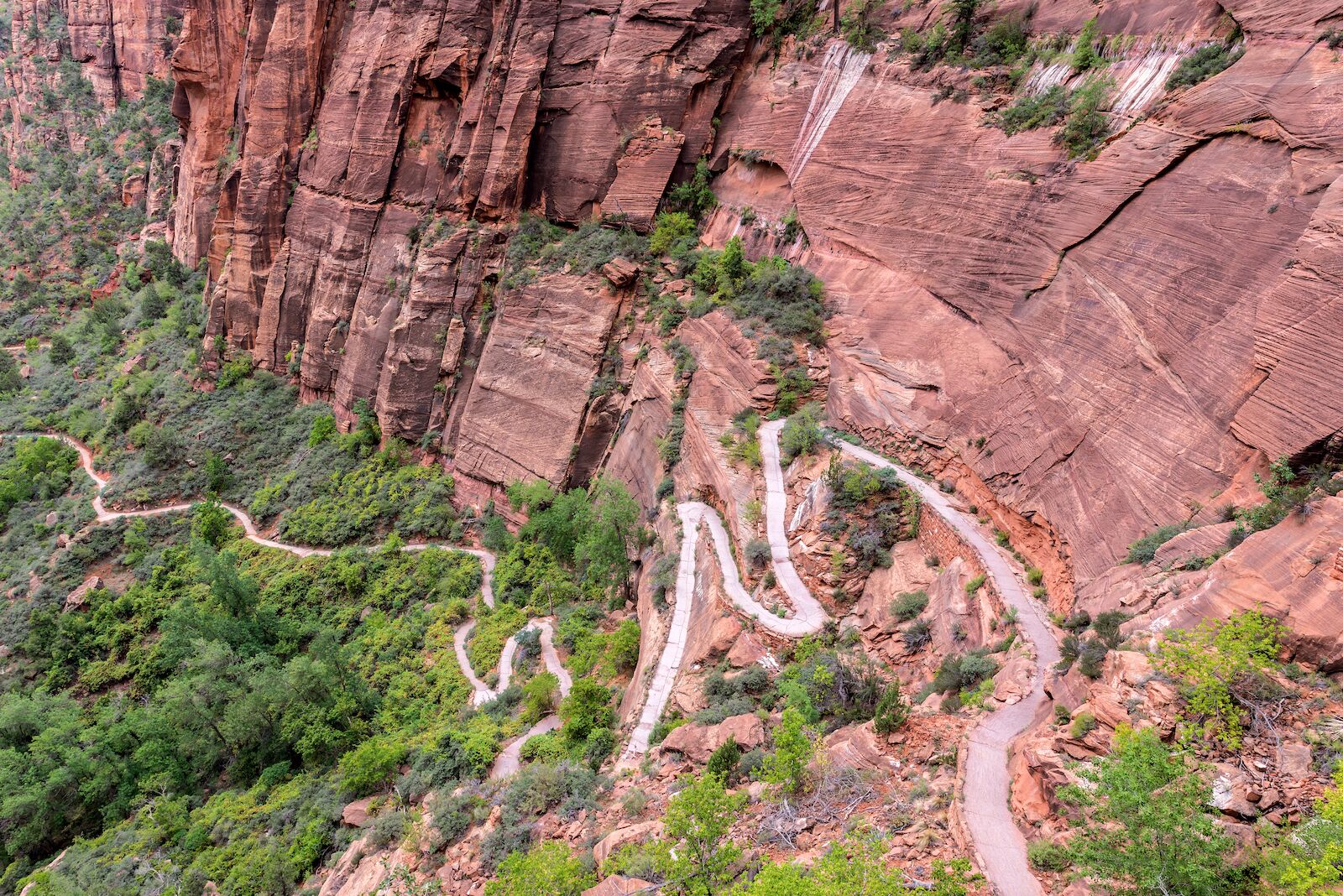
Knowing what it means when someone says “a trail has switchbacks” will ensure you don’t end up on a trail like this unexpectedly. Photo: Jess Kraft/Shutterstock
Learning hiking vocabulary can help you evaluate trail conditions and difficulty, get appropriate hiking gear, be a more environmentally responsible hiker, and in some cases, even save your life. After all, how could you possibly describe your location in an emergency if you don’t know the difference between frontcountry and backcountry or know how to identify switchbacks, scree, or a saddle?
This guide for beginners and intermediate hikers is a great start, and can immediately make you feel more prepared on the trail.
Hiking terms to describe terrain and surroundings
Access road

Photo: Tacio Philip Sansonovski/Shutterstock
At the most basic level, an access road is simply the road you take to access a trailhead. Usually, however, access roads mean non-paved or dirt roads designed for forest, park, or service vehicles to reach hard-to-access areas.
Backcountry
The definition is slightly less black-and-white than many other hiking terms, but generally speaking, backcountry refers to a wilderness area accessed by trails rather than roads. Backcountry campsites usually have no or very few amenities (a pit toilet, at best).
Frontcountry
The opposite of backcountry, this is a slightly more developed, accessible area that doesn’t necessarily require hiking to reach. Examples include trails near a park’s visitor center or drive-in campsites. Frontcountry hikes are usually mapped and signed better than backcountry routes.
False Summit

There’s nothing like the let down of getting to the summit…only to find out it’s not the summit. Photo: Joshua Resnick/Shutterstock
A bit of an optical illusion, a false summit is a peak that you thought was the tallest or final summit, but realize there’s actually a higher point left to tackle. Usually you’ll realize you’re at a false summit when you finally reach the crest, only to see the actual summit in the distance. False summits are usually good places for snack breaks.
Out-and-back
A hiking trail leading to a specific destination (such as a summit or lake) that follows the exact same route back to the starting point. Other options include point-to-point hikes (which start and end in different places) or loops, which start and end in the same point without retracing one’s steps.
Ridgeline
A noticeable, narrow edge on a mountain or hill, typically steep and elevated above valleys. Ridgelines often have direct trails at their highest points out to lookouts or drop offs. Narrow ridgeline hiking can be less-than-fun for hikers afraid of heights or on very windy days.
Saddle
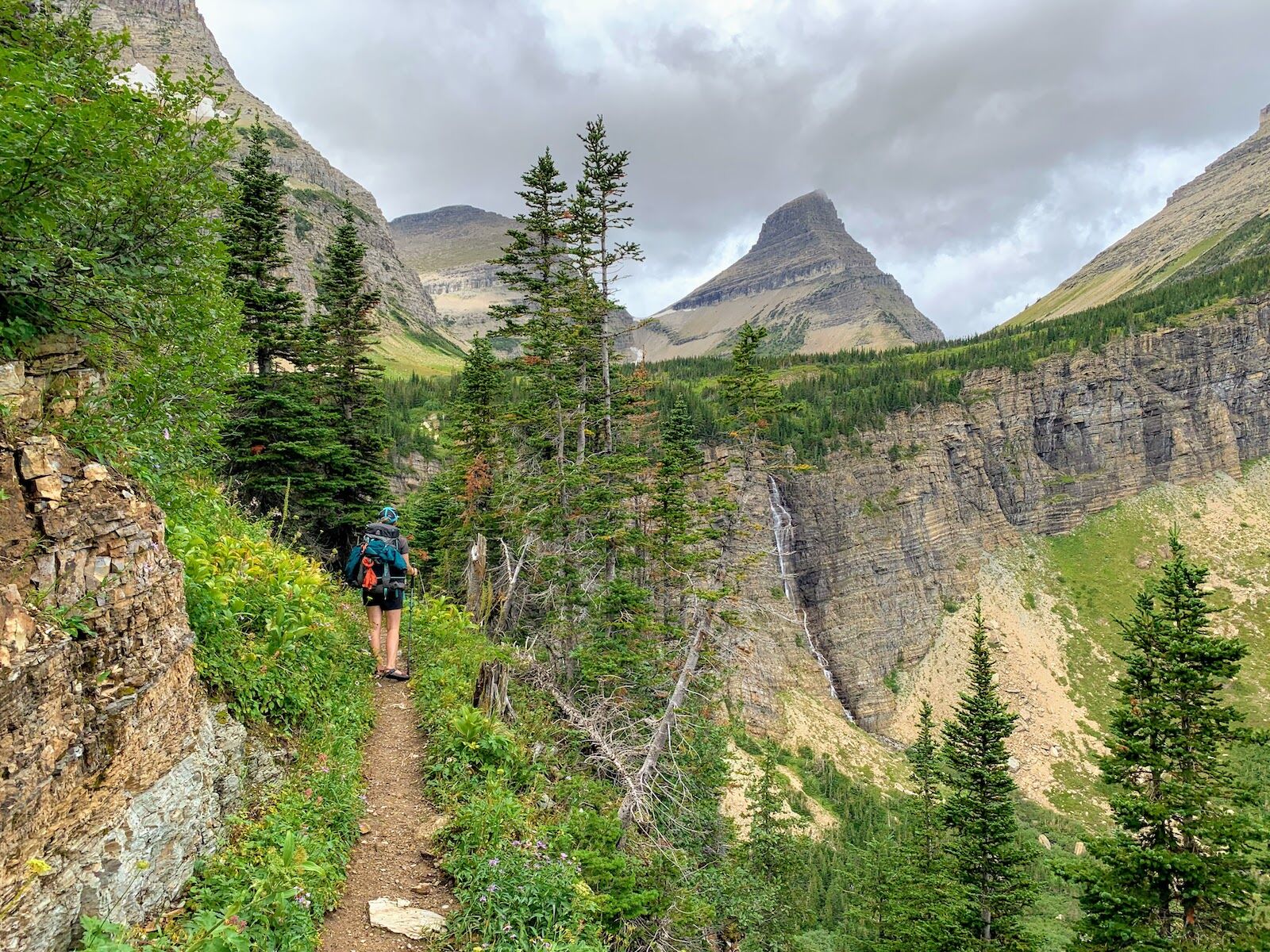
A hiker headed toward the saddle (the low, flat area above the waterfall and between ridgelines). Photo: Suzie Dundas
Literally, a “saddle” is a saddle-shaped landform connecting two higher points, such as peaks. Saddles are relatively flat in the middle and gradually get higher at either end. If you’re hiking between valleys, crossing a ridgeline at the saddle means crossing at the lowest point.
Scramble
A cross between hiking and non-technical rock climbing, scrambling involves using your hands and feet to navigate a steep or rocky area. Scramble can be a verb, or it can be used to describe a section of trail (ex: “The loose, uphill section after the trail sign is a bit of a scramble.”)
Scree
A section of loose, small rocks usually on a slope that make it necessary to hike carefully and watch your step. These are also called “scree fields” and can be thought of as being similar to sections of loose, large pieces of gravel.
Singletrack

This trail is considered singletrack as there’s no way for two people to safely walk side by side for an extended period. Photo: Maridav/Shutterstock
A very narrow trail or section of trail typically only wide enough for one person, often through a tightly wooded area or with other surroundings that make off-trail travel difficult. This is also a mountain biking term, so in some cases, singletrack refers to an even narrower trail primarily used by cyclists.
Spur Trail
A short trail “spurring” off the main trail, usually leading to a point of interest such as a great view or wilderness campsites.
Switchback
Tight, zig-zag-shaped corners on trails that make navigating steep sections more manageable. Think of these as sections of trails that quickly “switch back” and forth in direction. Some trails are built with switchbacks to control erosion, so it’s best to stick to the switchbacks rather than making a more direct (and steeper) route between them. A non-technical hiking term for a switchback could just be a “tight corner.”
Talus
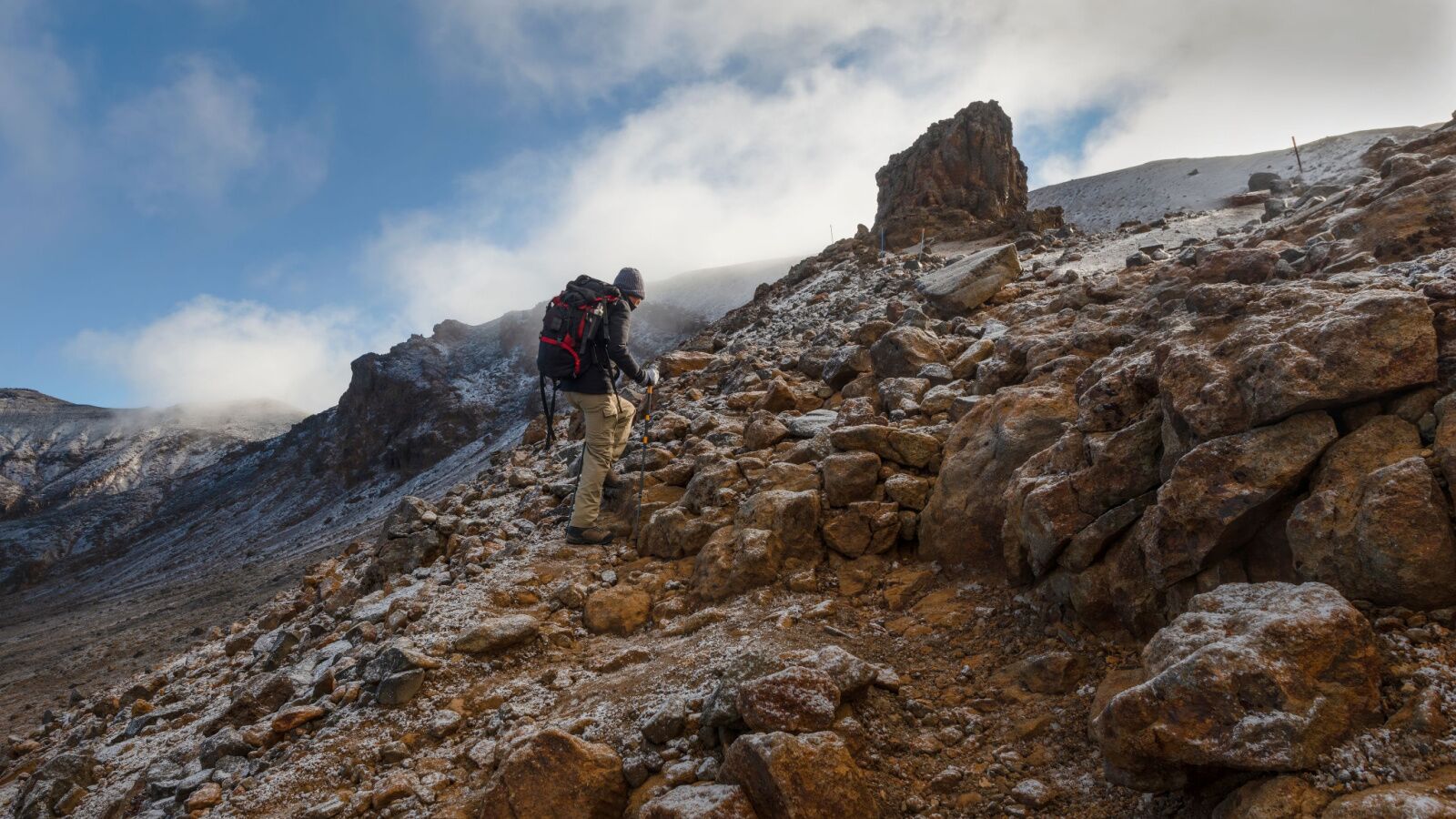
Walking up a talus field. Photo: Janice Chen/Shutterstock
Similar to a scree field, a talus field is a steep section of fallen rocks, though the rocks can be quite large and are often caused by rock slides or massive earth movements. Talus fields are usually not as loose as scree fields but may require boulder crossings. Talus fields are usually scrambles if you’re going up them, rather than across. “Talus slide” is also one of the more common hiking terms, but it means the same thing.
Treeline
A visible “line” across a mountain above which the environment doesn’t allow for trees to grow. You’ll often hear hikers refer to different parts of a trail as above or below treeline. Above treeline is often much colder and windier as there’s no growth to offer protection. When camping, it’s usually more comfortable to stay below treeline if possible.
Hiking terms to describe gear
Base Weight
The weight of all your backpacking or day hiking gear without consumables added. In hiking terms, a consumable is anything you’ll use over the course of your trip (such as food, water, propane, or sunscreen). Sometimes people even include the weight of their hiking shoes or baseball caps in this total.
Bear Bag

Bear bangs hanging from a bear pole. Photo: Suzie Dundas
Very similar to a dry bag, a bear bag is a weather-resistant bag that can be hung from a tree or bear pole away from camp to store food, toiletries, and anything else scented to keep it away from bears. To use a bear bag, you’ll also need a carabiner, some paracord or lightweight rope, and a branch or pole high enough off the ground that a bear won’t be able to reach it. Some hikers use scent-proof bags inside the bear bags as a further layer of bear deterrent.
Bear Box
Bear-proof storage lockers along some trails and campsites in areas where there are known bear populations. Note that in many areas with bear boxes, overnight campers are required to use them. Bear boxes usually have a latch system or some other system to keep them closed. Anything with a scent needs to go into a bear box, including items like sunscreen or deodorant.
A note about bears: bear boxes and bear bags are designed to keep bears away from your food so they don’t associate people with food. This is usually for the bear’s safety, not because bears are aggressive toward people. Humans are not prey for bears and they’ll usually run away from hikers and human noise. It’s important to keep wildlife wild by not feeding them (including tiny animals like chipmunks).
Bivouac, or bivy sack
Temporarily camping without a tent or much gear, most often done to get just a few hours of sleep or sometimes in an emergency, such as when inclement weather forces you to stop sooner than you planned or not make it to your campsite before nightfall. Bivy sacks look similar to sleeping bags, but with a raised area around the head. They’re used without tents and almost exclusively by ultralight campers in warm-weather, dry conditions (or emergency situations).
Cache
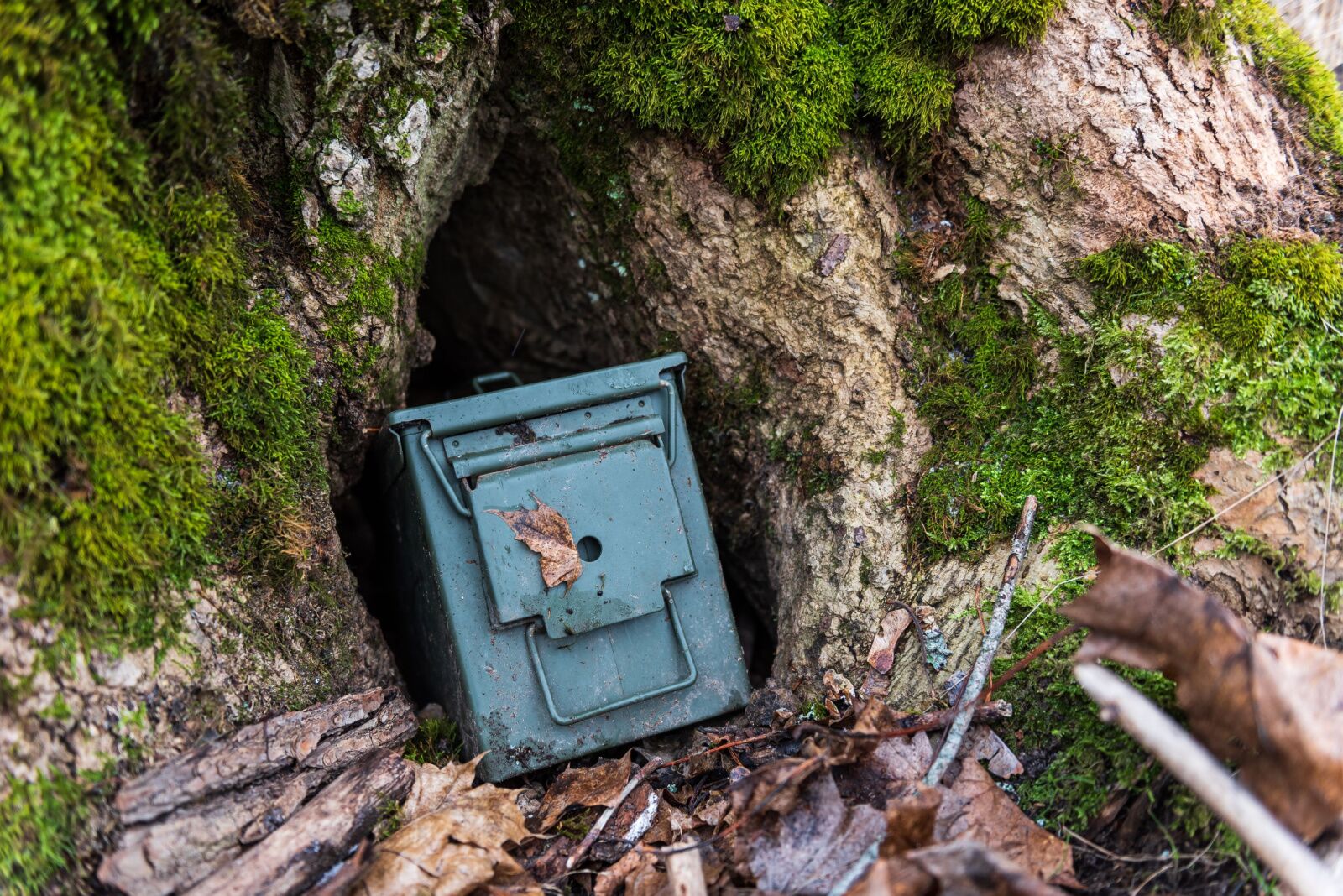
Photo: Bargais/Shutterstock
A location along a long-distance trail where backpackers can store food, water, and gear in advance to resupply along their route. A cache can also refer to a waterproof storage box near the summit of a trail, usually filled with items left by other hikes like notebooks, lighters, or maps. Similar to geocaching, except these “caches” are usually easy to find and meant to be discovered by hikers.
Cairn
Cairns are human-made stacks of rocks used as trail markers or to indicate something noteworthy on a trail, such as a scenic photo spot or a summit. Note that cairns are somewhat controversial and completely banned in many designated wilderness areas as they don’t follow Leave No Trace principles and can confuse hikers when not used for navigation. Cairns are called “ducks” in some parts of the US.
Crampons
Traction devices that fit over boots to dig into ice, light snow, and other slippery services are called crampons. These are often referred to as “microspikes,” though that’s technically a trademarked product name from Kahtoola (which makes traction devices for hiking).
Pack it In/Pack it Out
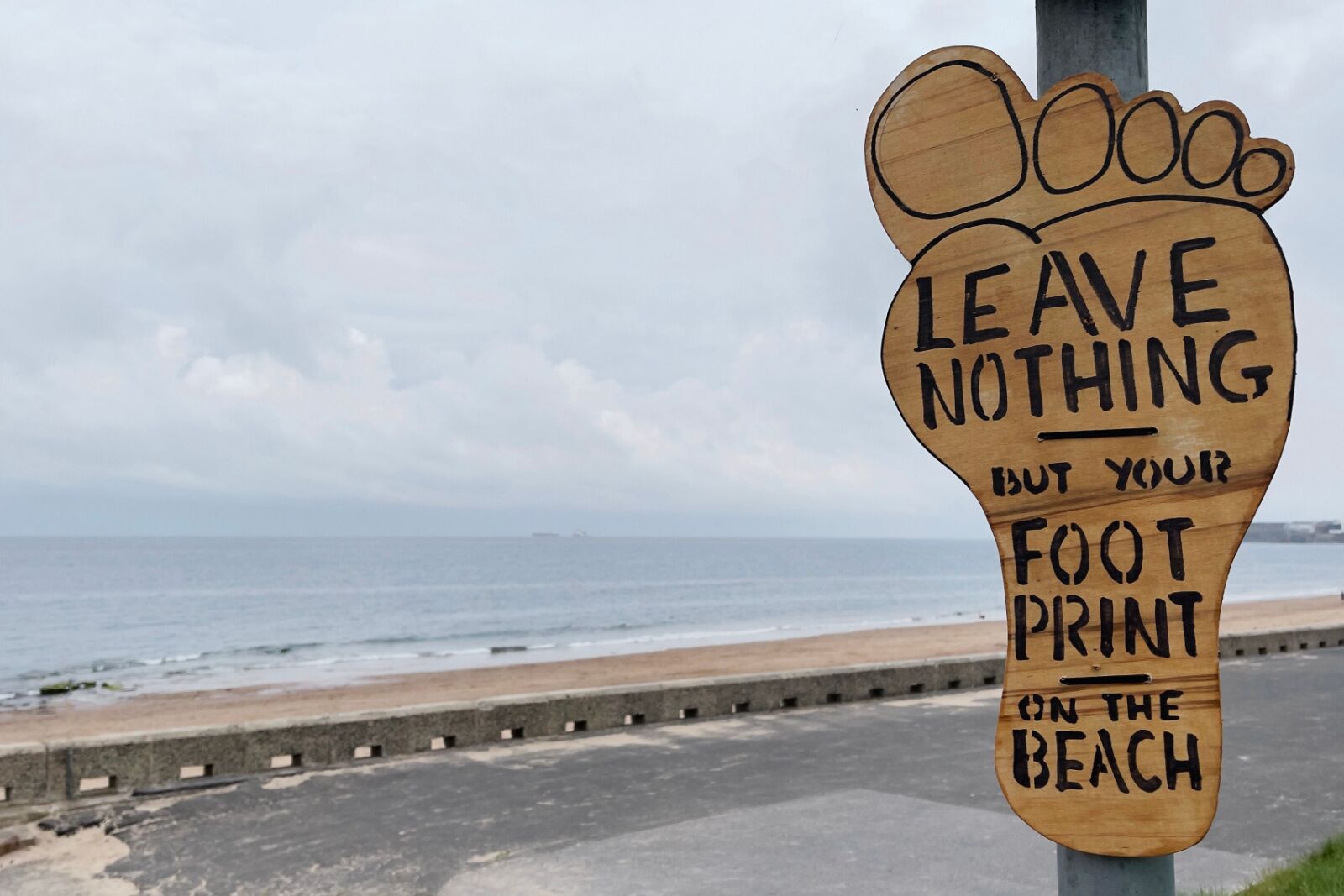
Photo: Darren William Hall/Shutterstock
One of the most important Leave No Trace principles, packing it out is the practice of taking everything you bring in with you back out from the trail; leaving absolutely nothing behind. This includes food and sometimes human waste.
The 10 Essentials
A widely-used list of 10 types of items hikers should always carry for safety and comfort, including some type of shelter, extra food, and a fire-starting device. Many hikers pick and choose which of the 10 essentials they’ll carry on any given hike based on the difficulty, while other hikers always carry all 10, regardless of the length or challenge.
Ultralight
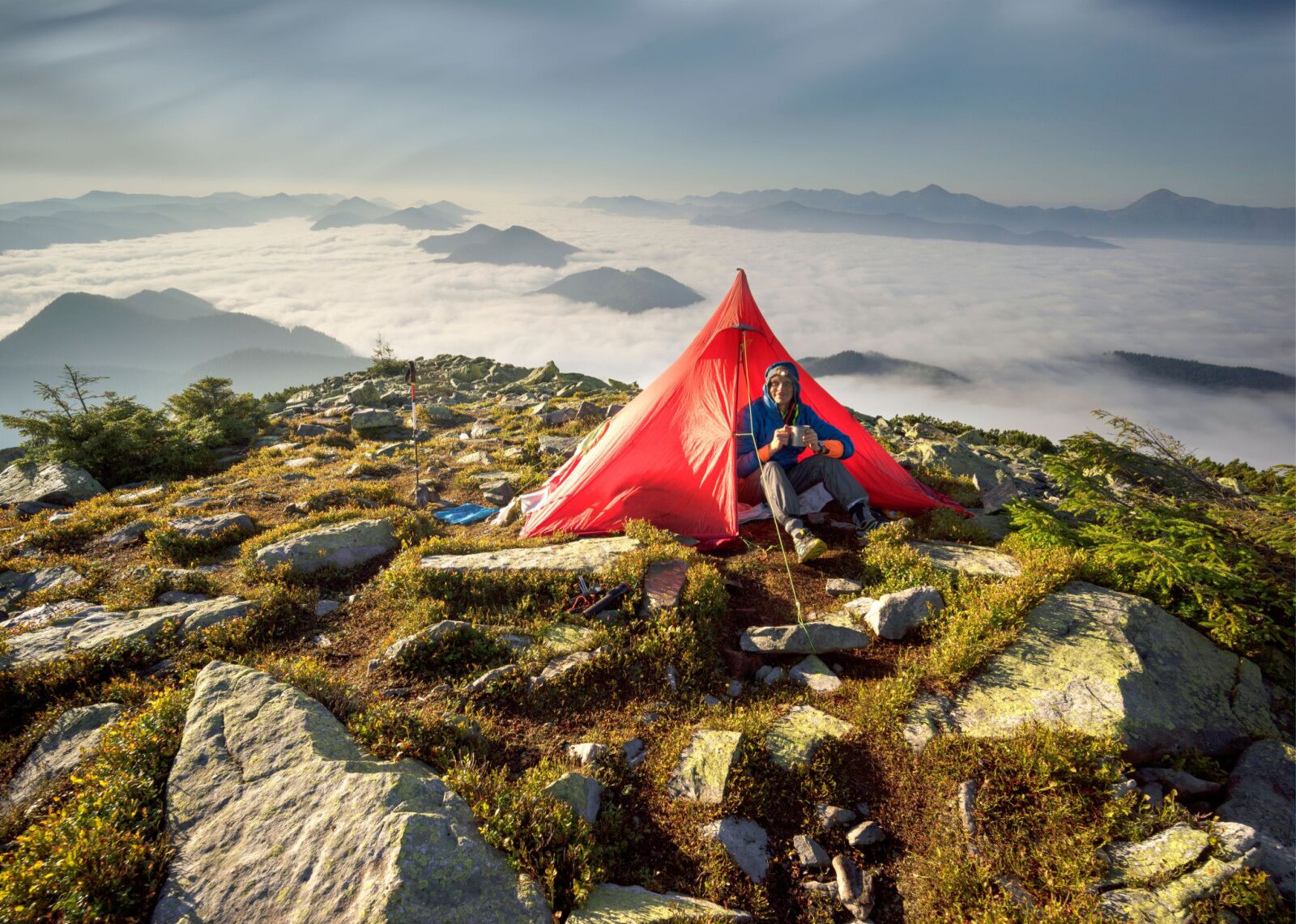
Ultralight campers prioritize keeping their weight low, which often means using rain flys on hiking poles, rather than full tents. Photo: Roman Mikhailiuk/Shutterstock
A minimalist style of backpacking and hiking that prioritizes carrying the lowest weight possible.
Other common hiking terms to know
Blaze

Trailheads often have signs to indicate which colors a certain trail follows. Photo: Suzie Dundas
A trail marker, typically on trees but sometimes on rocks or posts, and almost always color-coded. Blazes can be paint marks or flags tied to trees and mark specific routes. If you get lost, look for the appropriately colored blaze to find your way. You may hear people say things like “Follow the oranges blazes to stay on the trail.”
Bushwhack
To hike off trail, usually through dense vegetation.
Cat Hole
A small, shallow hole dug with a trowel (or “poop shovel”) for safely disposing of human waste.
Giardia
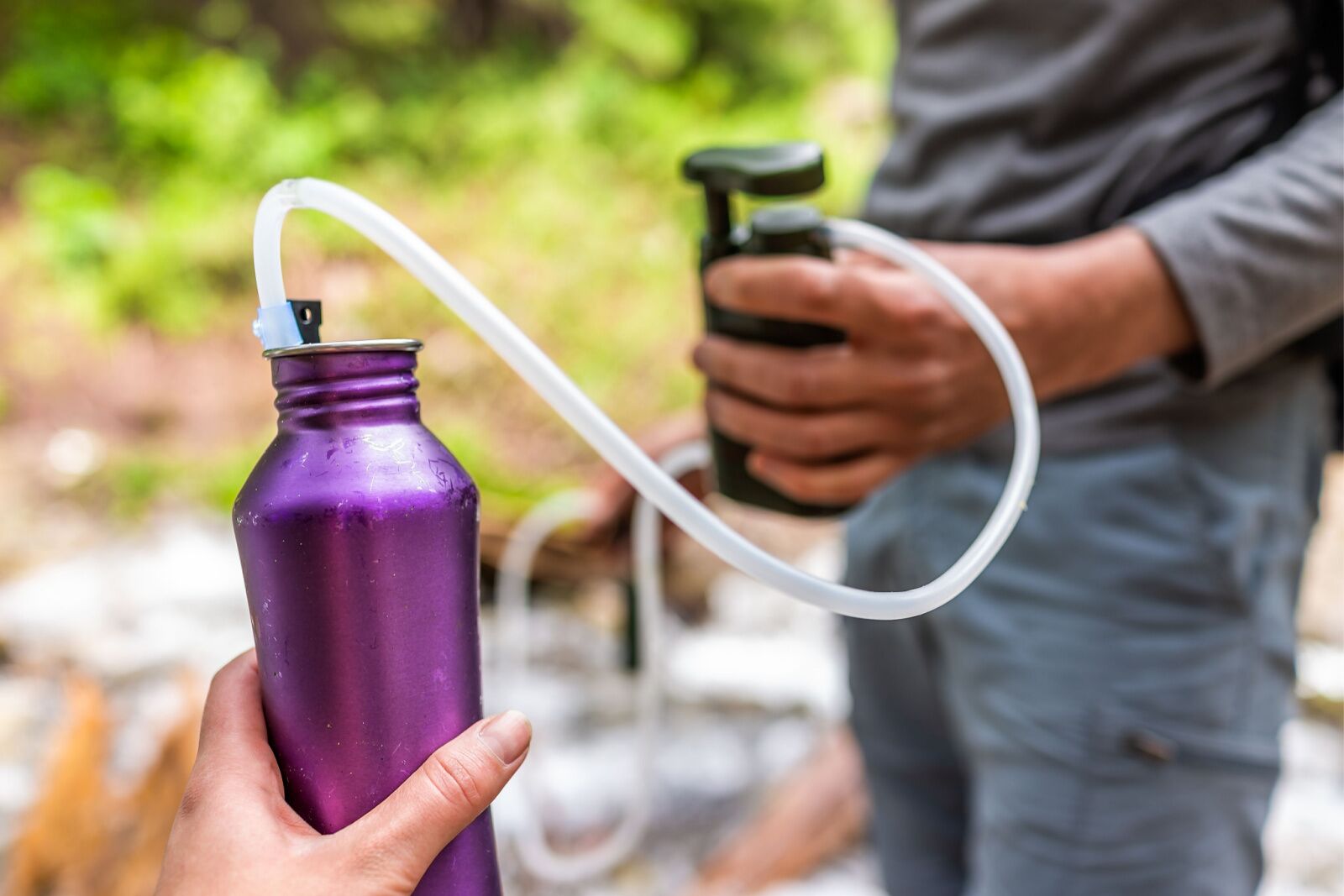
Filtering — or otherwise treating water — should keep humans and animals safe from nearly all water-borne diseases. Photo: Kristi Blokhin/Shutterstock
Also called Giardiasis, Giardia is a digestive tract parasite that hikers and campers can contract from drinking unsafe, unfiltered water. Dogs are especially vulnerable to giardia, but using a water filter can safely prevent the parasite in humans and dogs. It’s treatable with antibiotics.
LNT/Leave No Trace
A seven-principle code of ethics outlining how to recreate responsibly outdoors, including properly disposing of waste, traveling only on durable surfaces, and respecting wildlife.
Peak-bagging
Summiting several mountain peaks, typically in the same geographical area, such as Colorado 14ers (peaks with summits above 14,000 feet high) or the Presidential Range in New Hampshire. “Peak baggers” are hikers usually trying to check off a list of summits, often in a set time range (ex: attempting to peak bag all of Colorado’s 14ers in a single year).
Section Hiker
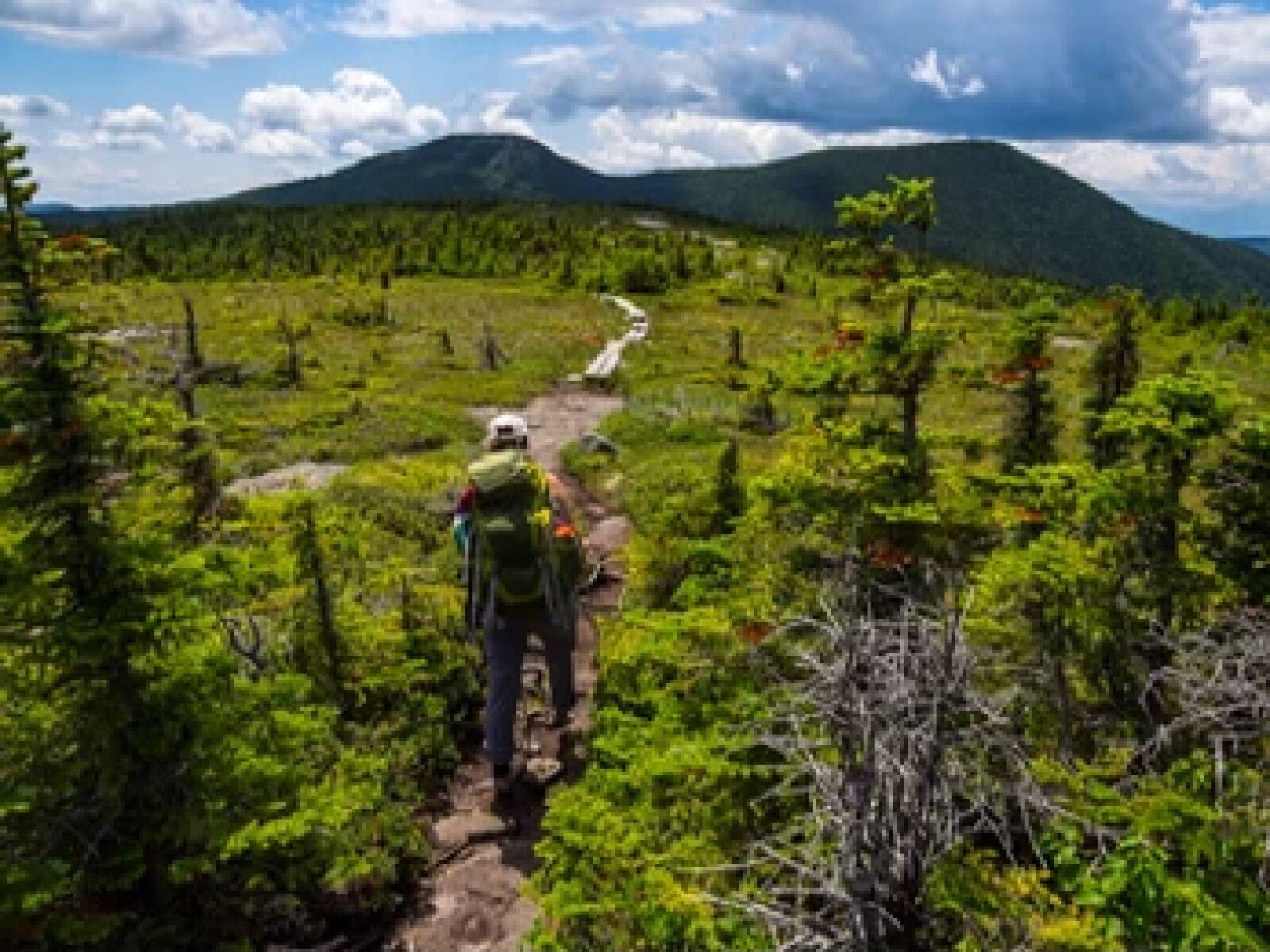
Photo: Jonathan A. Mauer/Shutterstock
Someone who completes a long-distance hike such as the Appalachian Trail or the Pacific Crest Trail in segments, rather than in one attempt.
Shuttle
Getting a ride to one end of a trail or pre-arranging vehicles at both ends, particularly on a point-to-point hike where the start and end points are too far from each other to walk. One of the most important hiking terms to know if you like the idea of not walking all the way on a trail you thought would be one-way only.
Thru Hiker
(Yes, it’s usually spelled “thru.”) A thru-hiker is someone who hikes a long-distance trail like the AT or the PCT from end-to-end in one season (as opposed to section hiking). In hiking terms, this usually means they do it in one long trip without returning home, but they may spend a night or two off the trail in small towns once or twice to resupply or take a rest day.